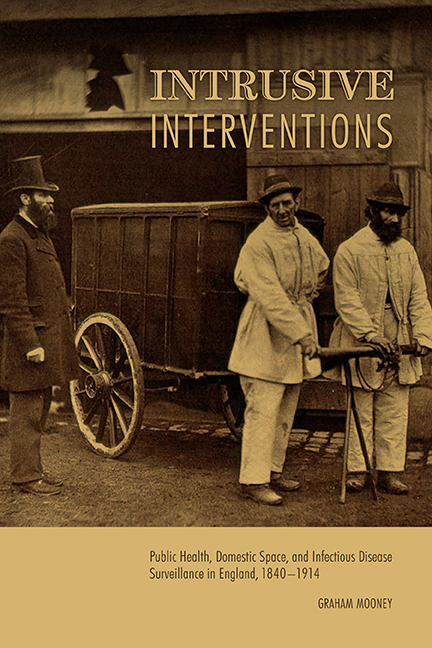 Intrusive Interventions
Intrusive Interventions Book contents
- Frontmatter
- Dedication
- Contents
- Acknowledgments
- Abbreviations
- Introduction
- Part One Making Infectious Disease Surveillance
- 1 Finding Disease in the Victorian City
- 2 “These Bastard Laws”: Infectious Disease, Liberty, and Localism
- Part Two Spaces of Risk and Opportunity
- Conclusion
- Notes
- Bibliography
- Index
1 - Finding Disease in the Victorian City
from Part One - Making Infectious Disease Surveillance
Published online by Cambridge University Press: 14 March 2018
- Frontmatter
- Dedication
- Contents
- Acknowledgments
- Abbreviations
- Introduction
- Part One Making Infectious Disease Surveillance
- 1 Finding Disease in the Victorian City
- 2 “These Bastard Laws”: Infectious Disease, Liberty, and Localism
- Part Two Spaces of Risk and Opportunity
- Conclusion
- Notes
- Bibliography
- Index
Summary
The English System of infectious disease surveillance crystalized in the latter part of the nineteenth century, when preventive interventions such as hospitalization and disinfection blended with scientific discoveries in aseptic surgery and bacteriology. Legislatively speaking, the fulcrum for this was the Infectious Disease (Notification) Acts of 1889 and 1899. These acts forced general practitioners to report cases of infectious disease to the local sanitary authority, which then pursued existing public health laws to isolate patients in hospital, disinfect property and belongings, suspend schooling, and temporarily close businesses.
Most accounts of public health ideology and practice in the late nineteenth century accept that infectious disease surveillance was a “modern” response to age-old biological threats. This is reflected in the terms that historians use to depict the triad of notification, isolation, and disinfection. Peter Baldwin's “neoquarantinist techniques” indicate that, to some extent, the English System was new wine in old bottles: quarantine and fumigation were refined and repackaged as isolation and disinfection. Expanding on ideas put forward by Margaret Pelling, Michael Worboys's “exclusive” public health stresses how bacteriology put the focus of intervention onto individuals and their behaviors, in contrast to the “inclusive” approach of environmental sanitation that prevailed earlier in the century. There are shades of this in David Barnes's phrase the “sanitary-bacteriological synthesis,” in which “the commonsense cultural appeal and broad applicability of the old knowledge (for example, that foul-smelling substances are bad for one's heath) … [were brought] into harmony with the specificity and scientific mastery inherent in the new knowledge of microbes.”
The discovery of infected individuals and the management of their behavior was, however, something more than just a rejuvenated preventive apparatus that held up a mirror to medical science. It was a public health policy that expressed modern liberal government. Victorians sought to impose some sort of order on their increasingly complex and sprawling cities. Information about rapidly growing populations enabled government to tax, plan, and regulate. Historians’ interest in these aspects of modern urban life is echoed in the proliferation of “governmentality” studies of censuses, maps, surveys, and the collection of data.
- Type
- Chapter
- Information
- Intrusive InterventionsPublic Health, Domestic Space, and Infectious Disease Surveillance in England, 1840-1914, pp. 19 - 39Publisher: Boydell & BrewerPrint publication year: 2015
